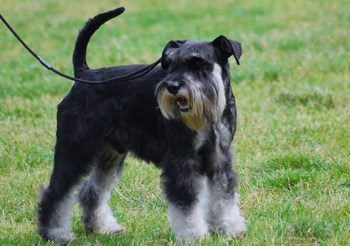 Obviously, the size of a Miniature Schnauzer can vary from dog to dog. There are some differences when it comes to body size and build type. I have come across Miniature Schnauzers that are very small and others that are almost the size of a Standard Schnauzer.
Obviously, the size of a Miniature Schnauzer can vary from dog to dog. There are some differences when it comes to body size and build type. I have come across Miniature Schnauzers that are very small and others that are almost the size of a Standard Schnauzer.
The Miniature Schnauzer was bred down in size from the Standard Schnauzer by selective breeding with smaller breeds. These other breeds include the Miniature Pinscher and the Affenpinscher. They may have also been crossbred with Toy and Miniature Poodles. They were not recognized as a different breed from the Standard Schnauzer until 1926.
Miniature Schnauzers that are bred for show purposes will have less variation from the standard size as they are judged by a breed standard.
The standard size of a Miniature Schnauzer
Male Miniature Schnauzer – Height: 14 inches (36 cm) at the shoulder. Weight: 11 lbs to 18 lbs (5kg to 8.2kg)
Female Miniature Schnauzer – Height: 13 inches ( 33 cm) at the shoulder. Weight: 10 lbs to 15 lbs (4.5kg to 6.8kg)
Is a Miniature Schnauzer a small or medium dog
A small breed dog is considered to be any dog that weighs between 11 lbs to 22 lbs (5 to 10 kg). If your Miniature Schnauzer is over this weight they are still considered a small breed dog. A Miniature Schnauzer that weighs under 11 lbs (5kg) when fully grown is often referred to as a “Toy” breed. They are in fact not a different breed.
Why your Miniature Schnauzer may be bigger or smaller
If your Miniature Schnauzer is a show dog or bred from show dog lines they are more likely to be close to the standard measurements given above.
If they were bred to be pets they may vary from the show standard. The body type of a pet Miniature Schnauzer can differ. Some have a lean build while others can be more of a stocky build. Many breeders also try to breed very small puppies. This is to meet the demand for a “toy” type version of the Miniature Schnauzer. This is not a separate breed. The danger with these tiny Schnauzers is that they don’t seem to be as hardy as a normal-sized Miniature Schnauzer.
The weight of your Miniature Schnauzer may also vary from the standard guide. There are many reasons for this. As a result of having been spayed or neutered a dog can sometimes see a drastic weight increase.
Obviously, Schnauzers that are overfed can be heavier and often older dogs become less active and sedentary leading to weight gain.
The biggest factor that will determine the size a Miniature Schnauzer puppy will grow to is the genetics passed on by the parents. If you want to know how big your Miniature Schnauzer will become, check out the parents.

At what age is a Miniature Schnauzer fully grown
Typically, a Miniature Schnauzer’s bones will have reached full size with the growth plates healing by about 11 to 12 months old. Height wise they will be pretty much the height they are going to be somewhere between 10 to 12 months old.
This doesn’t mean they would have reached full size. A Miniature Schnauzer will often gain additional weight and develop a stocky build They often will not have reached their maximum weight until about 18 months of age.
Often there will be one or two “Runts” in a litter of Miniature Schnauzer puppies. Even tho these pups start off smaller they usually bridge the size gap between themselves and their siblings. In some cases, they may even grow bigger than their littermates. Picking the runt because you want a small Miniature Schnauzer is no guarantee.
Miniature Schnauzer vs Standard Schnauzer – differences and similarities
Although the Miniature Schnauzer is descended from the Standard Schnauzer they are a completely different breed. There are many differences as well as many things that are similar between the two breeds.
The obvious main difference between a Standard Schnauzer and a Miniature Schnauzer is size. A Standard Schnauzer typical size is 18-20 inches (46-51 cm), 30-45 pounds (14-20 kg) for a male and 17-19 inches (43-48 cm) 30-40 pounds (14-18 kg) for a female.
Both the Standard and Miniature Schnauzer are high energy and intelligent dogs that require plenty of exercise and mental stimulation. For a guide to the exercise needs of a Miniature Schnauzer see here. They also share a similar people-orientated personality and are in general good with children.
The coat of a Miniature Schnauzer and Standard Schnauzer can vary from dog to dog. However, a Standard Schnauzer tends to have a wiry, hard, and dense outer coat with a softer undercoat beneath. The Standard Schnauzer does on average shed a little more than a Miniature Schnauzer.
In comparison, a Miniature Schnauzer tends to have a finer softer outer coat and undercoat. This type of coat tends to matt easier than a coarse coat and may require more grooming and maintenance. Some Miniature Schnauzers do have a coarser coat similar to the Standard Schnauzer.
The lifespan of the two breeds is roughly the same being 13 to 15 or 16 years. Many factors can affect a dog’s life expectancy. This includes overall healthcare, diet, lifestyle and genetic factors.
When it comes to the popularity of Miniature and Standard Schnauzers, the Miniature Schnauzer tends to be a more popular choice. The AKC popularity rating has the Miniature Schnauzer at number 17 with the Standard Schnauzer being ranked at 85th.
Miniature Schnauzer related posts you may like: